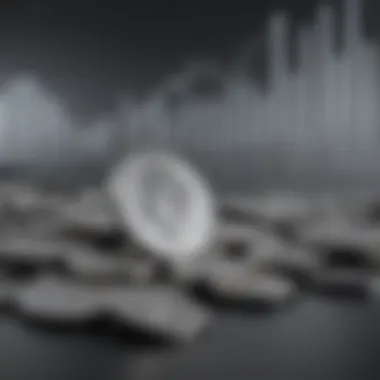Understanding Current Spot Silver Prices and Trends


Intro
Understanding the intricacies of spot silver prices is crucial for investors looking to navigate the choppy waters of precious metal investments. Silver, often dubbed as the ‘poor man’s gold,’ holds significant value, not just as a safe haven asset but also in various industrial applications. The current landscape of spot silver prices is shaped by a multitude of factors, from economic indicators to supply-demand dynamics.
In a world where market sentiment can shift in the blink of an eye, grasping the underlying aspects of silver investments can empower investors—both fledgling and seasoned alike. This article delves deep to unwrap the components influencing spot silver prices and helps readers formulate strategies to position themselves effectively in the market.
Before diving into specifics, let's define some key terms that will prove indispensable throughout our exploration.
Key Terms and Definitions
Explanation of Investment Terminology
When it comes to investing in silver, certain terminology is commonplace. Being familiar with these terms can aid novices in making informed decisions. Here’s a quick rundown:
- Spot Price: The current market price at which silver can be bought or sold for immediate delivery. This price fluctuates due to changing market conditions and is determined by supply and demand.
- Futures Contracts: These are agreements to buy or sell silver at a predetermined price at a specified future date. This can be a tool for hedging against price volatility.
- ETFs (Exchange-Traded Funds): Investment funds traded on stock exchanges much like stocks. These funds can hold physical silver or silver-related securities, allowing investors to gain exposure without directly buying the metal.
Commonly Used Financial Products
Silver investments are not limited to physical bullion or coins. Numerous financial products cater to varying risk appetites and investment strategies. Here are some widely utilized options:
- Physical Silver: Includes silver bars, coins, or rounds that can be stored personally.
- Silver Mining Stocks: Investing in companies that mine silver can be lucrative, especially during times of rising silver prices as their profits may increase significantly.
- Silver Certificates: A document that proves ownership of a specific amount of silver stored in a vault.
With these terms and products under our belts, we can transition into understanding how market dynamics like geopolitical tensions, economic reports, and currency fluctuations dictate the ebbs and flows of spot silver prices.
"Knowledge is power, especially in investment. Understanding the fundamentals can make the difference between profit and loss."
Next, let's dissect the factors that impact the ever-changing silver market.
Understanding Spot Silver
When it comes to investments, understanding the various markets is key to making informed decisions. Spot silver, in particular, is a critical component of the precious metals landscape, not simply because of its physical properties, but due to its broader economic implications. For both budding investors and seasoned professionals, grasping the nuances of spot silver can shed light on price fluctuations, investment opportunities, and global economic indicators.
As a precious metal that has been used for centuries, silver appeals to investors looking for a hedge against inflation or economic downturn. Prices can sway based on myriad factors, from demand in industrial applications to shifts in currency values. Recognizing these elements is not just beneficial; it’s imperative for anyone considering silver as an investment vehicle.
Definition of Spot Silver
Spot silver refers to the current market price at which silver can be bought or sold for immediate delivery. Unlike futures contracts or options trading, spot transactions involve a direct exchange of cash for the commodity. This immediacy makes spot silver a critical benchmark for valuation within the silver market.
The price of spot silver is determined by various factors including:
- Supply and Demand: The immediate availability of silver in the market versus how much buyers are seeking.
- Market Sentiment: Current economic news, trends, and investor behavior can sway prices in a matter of hours.
- Global Economic Factors: Trade policies, inflation rates, and geopolitical developments can play significant roles in spot pricing.
In essence, when one speaks about 'spot silver,' they are discussing the cost you would pay at that very moment to acquire the metal. And let’s face it, understanding this price is half the battle when it comes to effective investing.
How Spot Pricing Works
Spot pricing operates on a simple premise: supply equals demand. The spot price acts as the marketplace's way of gauging the immediate value of silver. Think of it like the daily price tag on your favorite marketplace item; if more people are buying it, the price may go up. Conversely, if nobody wants it, the cost may tumble.
In practice, spot silver prices are quoted in terms of price per ounce. Pricing can fluctuate throughout the day as trading occurs across various platforms, including electronic trading systems. Factors influencing these shifts include:
- Economic Indicators: Inflation rates, GDP growth, and employment figures can influence values.
- Geopolitical Uncertainty: Events like political unrest or natural disasters can lead to a surge in demand for silver as a safe haven asset.
- Production Costs: Changes in mining efficiency and regulations can affect overall supply.


For investors, watching market trends and spot price movements is crucial. Tools like real-time pricing platforms and analytics software come in handy, helping individuals and institutions alike navigate an ever-changing landscape. Equipped with this knowledge, investors can make more educated decisions about their stakes in the silver market, knowing when to enter or exit.
"By keeping a pulse on spot silver prices, investors position themselves to make intelligent, timely decisions, enhancing their portfolio's resilience and potential returns."
Current Spot Silver Price Analysis
The analysis of current spot silver prices serves as a critical barometer for investors so they can gauge market health and future potential in this precious metal. Understanding how the price of silver is influenced by a web of global and domestic factors can empower both novice and experienced investors to make informed decisions. The current landscape not only reflects the intrinsic value of silver as a commodity but also provides insight into larger economic trends, making it an important focus for anyone serious about investing in this asset.
Global Market Trends
When examining the current spot silver price, one can’t overlook the global market trends that play a pivotal role. The price of silver is not only a reflection of its supply and demand but also intertwined with various global events—economic reports, policy changes, and geopolitical tensions.
For instance, during periods of economic uncertainty or depreciating currencies, silver often emerges as a safe haven. Investors flock to it during tumultuous times, driving demand up, which in turn can lift prices significantly. Recent years have shown fluctuations due to the pandemic's impact on supply chains and manufacturing outputs, showcasing how interconnected the global economy is.
"The silver market operates on a finely tuned balance; one shift can have ripple effects that impact prices worldwide."
Recent Fluctuations
In the context of recent fluctuations, it’s essential to look at specific price movements and events that triggered them. For instance, the market observed a surge earlier this year when reports indicated a rise in industrial demand for silver, particularly from the electronics sector. Conversely, prices have also dipped when Federal Reserve signals hinted at interest rate hikes, altering the appeal of precious metals.
Additionally, seasonal factors can contribute to volatility. For example:
- Winter months: Typically see increased jewelry sales in certain cultures, often edging prices upwards.
- Summer months: May witness a slowdown as industries scale back output, putting downward pressure on prices.
- Manufacturing Reports: As a barometer for demand, any changes can cause significant shifts in spot prices.
Keeping an eye on these trends can help investors anticipate movements rather than react post-factum.
Technical Analysis of Current Prices
Technical analysis is key in deciphering how silver prices are projected to behave in the short and medium-term. This method relies heavily on historical price data to identify patterns and form predictions about future movements.
Investors often leverage tools such as moving averages, resistance levels, and support factors:
- Moving Averages: The 50-day moving average often serves as a significant indicator; prices above this average may suggest bullish sentiment.
- Resistance Levels: Identifying where prices tend to reverse can provide insights for selling positions.
- Support Levels: Conversely, support levels can indicate where investors may enter the market due to perceived value.
Incorporating this analysis allows investors not only to make well-informed decisions but to time their investments more effectively, enhancing potential profits while managing risks.
Understanding these elements in the current spot silver price analysis equips investors to navigate the complex landscape of silver investing with greater confidence.
Factors Influencing Spot Silver Prices
Understanding what drives the price of spot silver is crucial for any individual looking to invest their hard-earned money. These factors don’t act in isolation; they intertwine in a complex dance that investors must comprehend to gauge future movements in silver prices. By analyzing these variables, you can craft a more thorough investment strategy and spot opportunities that align with your financial goals.
Economic Indicators
Economic indicators serve as the heartbeat of market movements. Think along the lines of unemployment rates, GDP growth, and consumer spending. For instance, when an economy is on a healthy growth trajectory, demand for industrial silver tends to rise. This can drive the prices upward. Conversely, an economic downturn often leads to lower demand, which can have a dampening effect on silver prices.
Moreover, monetary policy is a significant player. When central banks decide to cut interest rates, investors often flock to silver as a hedge against inflation and currency depreciation. In this context, the relationship between silver and interest rates cannot be understated. A low-interest environment can make gold and silver more attractive compared to traditional savings, causing their prices to go up.
Geopolitical Events
Geopolitical events tend to stir the pot in the markets. Escalating tensions—be it war, trade disputes, or even natural disasters—can lead to increased volatility. Silver is often seen as a safe haven during such tumultuous times. Investors seeking refuge from uncertainty might turn to silver, causing a spike in spot prices.


For example, consider the implications of a significant political upheaval in key countries that mine silver. The risk of disruptions can cause supply concerns, immediately impacting prices on global markets. Additionally, any sanctions or trade policies affecting silver exports can create ripples throughout the market.
Demand and Supply Dynamics
The interaction of demand and supply is what really decides the price tag for silver. On the demand side, industrial applications have grown over the years, from electronics to renewable energy technologies, which bolsters the need for silver. Yet, when the supply from mining operations does not keep pace with rising demand, spot prices can increase dramatically.
Several factors influence supply, including mining conditions and geopolitical circumstances in mining countries. Should a major mining country face operational challenges, the effect on global silver supply could be profound. So, keeping an eye on mining companies and their production forecasts can offer valuable insights for potential investors.
Inflation and Currency Value
Inflation acts as a double-edged sword for investors. On one hand, when inflation levels climb, the purchasing power of fiat currency declines, motivating investors to seek out tangible assets like silver. On the other hand, a strong currency can make silver more expensive for foreign buyers, potentially dampening international demand.
In essence, when inflation rates rise in major economies, silver gains appeal as a store of value, which can push its price upward. Conversely, if the dollar strengthens considerably, it may pressure silver prices down—something to keep in mind while navigating the markets.
"Silver often acts as a bellwether for economic sentiment, reacting sharply to shifts in economic indicators and geopolitical dynamics."
To sum up, prices of spot silver are far from static; they are shaped by an array of factors ranging from economic indicators and geopolitical unrest to demand-supply interactions and currency fluctuations. For those looking to invest, remaining attuned to these factors can markedly enhance your strategic approach in a complex market. Understanding these influences is like having a compass in uncharted waters—essential for making informed investment choices.
Historical Context of Silver Prices
Understanding the historical context of silver prices is crucial for anyone looking to invest in this precious metal. The trajectory of silver throughout history not only shapes investor psychology but also informs current market dynamics. Having a grasp of past performance, including cycles of booms and busts, equips investors with the ability to make more informed choices in today's market.
Long-Term Trends
Silver has journeyed through various phases over the centuries. Notably, the price of silver has endured significant fluctuations, deeply intertwined with the global economy and periods of financial stability or turmoil. For instance, during the late 19th century, silver gained traction as a monetary standard in many countries, especially in the United States after the Coinage Act of 1873, which switched the nation to a gold standard. This shift had long-standing implications for silver prices, often leading to volatility in response to economic policies.
In recent decades, the price of silver has demonstrated a strong correlation with factors like industrial demand and investment trends. During the 1970s' inflation crisis, prices soared to historic highs, reaching nearly $50 per ounce in 1980. This surge was not just a product of inflationary fears but also a reflection of the strong demand for silver in various industries—electronics, for example, has increasingly relied on this metal.
Comparative Analysis with Other Precious Metals
When examining silver’s performance against gold and platinum, it's revealing to note both its unique attributes and its similarities. Gold has long been regarded as a safe haven, making it the preferred choice during economic downturns. Conversely, silver often plays a dual role; it serves as both a monetary asset and an industrial commodity. This duality means it can be sensitive to shifts in industrial demand.
Silver's ratio to gold, known as the silver-to-gold ratio, is a useful measure for investors. Historically, this ratio has ranged widely; during times of economic uncertainty, investors may flock to gold, pushing its price up while silver may lag behind. Analyzing this ratio can lend insights into market sentiment, indicating whether silver is undervalued or overpriced relative to gold.
"The silver-to-gold ratio has varied through time, often serving as an indicator for potential investment strategies. Keeping an eye on this ratio can provide clues about when to enter or exit the silver market."
Furthermore, when one compares the overall market performance, silver tends to be far more volatile than gold. Its price can swing wildly based on market news or economic data releases. For instance, while gold may maintain a gradual increase, silver could shoot up or down by double-digit percentages within a short timeframe. Such volatility presents both risks and opportunities that savvy investors must weigh carefully.
In summary, a keen understanding of silver's historical context and its long-term trends relative to other precious metals can empower investors. By learning from the past, investors can navigate the currents of the present and make prudent decisions for their portfolios.
Investment Strategies in Spot Silver
Investing in silver is often an overlooked avenue compared to gold, yet it holds significant potential for both seasoned and neophyte investors. Understanding the intricacies of silver investment is crucial. "In the world of investments, silver often plays second fiddle to gold, but it has its own merits that can shine bright in a diversified portfolio."
Physical vs. Paper Silver Investments
When it comes to silver investments, one must first decide between tangible silver—strongly found in coins, bars, and jewelry—and paper silver, which involves contracts like ETFs or futures.
- Physical Silver: This allows investors to hold the metal in their hands, which some prefer due to its intrinsic value. Owning silver bars or coins can evoke feelings of security. However, storing physical silver can get cumbersome and costly. You’d need to consider safety, transportation, and potentially insurance too.
- Paper Silver: This is a more modern approach, offering ease of trading without the need for physical possession. ETFs that track silver prices, for instance, allow investors to buy shares that are equivalent to a specific amount of silver. This method is liquid and can be traded like stocks, but it comes with counterparty risks.
Assessing Risk and Reward


Like any investment, silver carries its risks. It's vital to weigh these risks against the potential rewards. The price of silver can be volatile, influenced by market trends and external factors. Before jumping in, one should consider:
- Market Volatility: Silver prices can swing dramatically in response to economic changes and geopolitical events. Understanding broader economic indicators helps assess the market landscape.
- Diversification: By adding silver to a portfolio, investors can spread their risk. This precious metal often behaves differently than stocks or bonds, providing a buffer in downturns.
"Diversification is not just a way to spread risk; it's a strategy to stability in uncertain times."
Incorporating Silver into a Diversified Portfolio
Incorporating silver into your investment mix can enhance your overall portfolio performance.
- Balance: Silver can help balance out the heavier reliance on stocks, especially during economic downturns when investors flock to safe havens.
- Timely Adjustments: Being flexible in your investment strategy allows you to take advantage of market conditions. If silver prices dip, it might be an opportune moment to increase your holdings.
- Hedging Against Inflation: Silver has traditionally been considered a hedge against inflation. Including it in your portfolio may safeguard your investments in times when currency devalues.
In sum, realizing the importance of silver as a part of your investment strategy can prove beneficial. Physical ownership provides a unique security, while paper investments offer liquid options. Evaluating your risk tolerance and adjusting accordingly can lead to a more robust portfolio that stands the test of time.
Future Projections for Spot Silver
Understanding future projections in spot silver prices is crucial for anyone involved in silver investments. Speculating on the direction of silver prices not only informs investment decisions but also helps gauge the market climate. These projections assess possible scenarios based on various economic and geopolitical factors, making them invaluable for both new and seasoned investors. Distilling these insights can illuminate potential opportunities and pitfalls in the ever-changing world of silver trading.
Analysts' Forecasts
Analysts play a key role in shaping expectations surrounding spot silver prices. Their forecasts typically reflect a blend of technical analysis, historical trends, economic indicators, and global events.
- Technical Analysis Trends
Analysts delve into charts and price movements. They look for patterns that suggest where prices might head next. If, for instance, silver has a history of responding to a particular economic cue, analysts will likely point that out. The use of various indicators, like moving averages or Bollinger Bands, can outline possible price reactions. - Economic Indicators
Analysts often tie silver price forecasts to macroeconomic factors like inflation rates, interest rates, and currency strength. For instance, if inflation is expected to rise, silver might appeal to investors looking to hedge against currency depreciation. The interplay between these elements can provide insight into where silver prices might trend. - Geopolitical Concerns
Tension in global politics can lead to uncertainty in markets, which may bolster silver prices as a safe-haven asset. Analysts frequently voice scenarios that incorporate these potential conflicts or resolutions, contributing to their price projections.
"A safe-haven asset like silver tends to witness increased demand during times of uncertainty."
Such forecasts, therefore, are based on a mosaic of factors. While they provide a clearer view of what might happen, investors should always proceed with caution, recognizing that forecasts can sometimes miss the mark due to sudden changes in the market environment.
Potential Market Challenges
Despite the promising outlooks, challenges loom on the horizon of the silver market.
- Economic Slowdowns
A downturn in global or local economies can spell trouble for silver prices. If industrial demand weakens due to reduced manufacturing activity, silver could face downward pressure. Monitoring economic reports can help investors stay ahead of such downturns. - Interest Rate Changes
Rising interest rates tend to boost the value of the US dollar, which can be detrimental to silver prices. As bond yields improve, safer assets may become more appealing compared to precious metals. Investors must be vigilant regarding central bank announcements and policies that could influence rates. - Market Speculation
The silver market can be susceptible to speculation, leading to volatile price swings that do not always align with fundamental values. Such behavior can be unpredictable and can sometimes lead to sudden market corrections. - Supply Chain Disruptions
Supply chain issues can create challenges in getting silver to market. Whether caused by war, natural disasters, or trade disputes, these disruptions can lead to volatility in prices, catching investors off-guard.
In summary, while future projections are essential for navigating the complexities of silver investments, both opportunities and challenges lie ahead. Investors are encouraged to stay informed and adaptable in this ever-evolving landscape.
The End
The conclusion of this article serves as a vital piece in synthesizing the discussions surrounding spot silver prices. It reflects on the myriad factors influencing the market, the historical context that gives depth to current prices, and the various strategies available to investors in this complex financial landscape. Here, we pull together the threads of various insights discussed throughout the article, emphasizing the importance of informed decision-making in the world of silver investments.
In considering spot silver as an investment, one must appreciate its dual nature. It can be both a store of value and a vehicle for speculation. Investors need to assess their financial goals carefully. Are you in it for the long haul, banking on the metal’s historical safety during tumultuous times? Or are you looking to profit from trading fluctuations? Each approach has its pros and cons, and aligning your strategy with your personal financial objectives is crucial.
Ultimately, investing in silver requires a blend of awareness, strategy, and adaptability. In a world where market conditions can shift overnight, the informed investor stands to gain the most.
Summarizing Key Takeaways
- Spot Silver Definition: Spot silver refers to the current price at which silver can be bought or sold for immediate delivery.
- Market Influences: Economic indicators, geopolitical events, and supply-demand dynamics significantly impact prices.
- Investment Strategies: Understanding whether to opt for physical silver or paper investments based on an individual's risk tolerance can greatly influence outcomes.
- Historical Perspectives: Looking at past trends provides context for current market behavior and can guide future predictions.
By distilling these insights into core takeaways, investors can establish a solid foundation for their silver investment journey. Knowledge is power, and understanding these elements will enable participants in the market to make more calculated and beneficial decisions.
Final Thoughts on Investing in Spot Silver
Investing in spot silver should not be approached lightly. The allure of rising prices often comes with hidden complexities that can trip up even the most seasoned investors. It’s essential to stay abreast of changing market conditions and external factors that can shift silver prices dramatically over short periods.
As silver maintains its role as a hedge against inflation and currency depreciation, it remains pertinent for savvy investors to incorporate it intelligently within a diversified portfolio.
Investors are encouraged to engage with reliable sources of market analysis and insights, pooling knowledge from various platforms, whether it's from articles like this or community discussions on forums such as Reddit.
By remaining vigilant and well-informed, participants can better position themselves to benefit from the volatile yet potentially rewarding nature of spot silver investing.



